Unit 12 I go to school by bus 课件(共53张PPT,无动画素材)
文档属性
| 名称 | Unit 12 I go to school by bus 课件(共53张PPT,无动画素材) |  | |
| 格式 | ppt | ||
| 文件大小 | 9.1MB | ||
| 资源类型 | 教案 | ||
| 版本资源 | 湘少版 | ||
| 科目 | 英语 | ||
| 更新时间 | 2021-06-28 22:26:07 | ||
图片预览

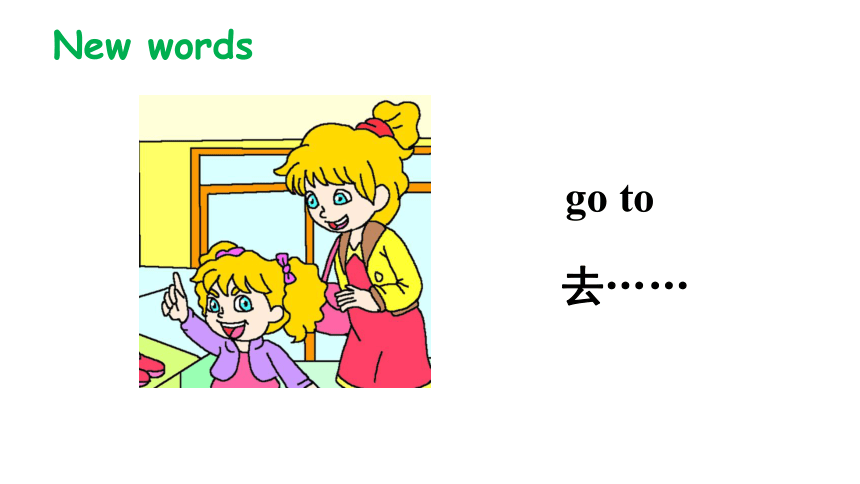
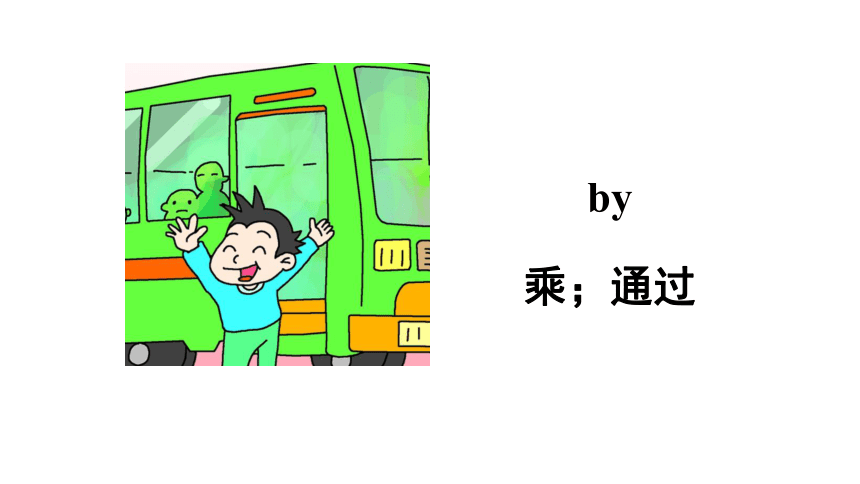

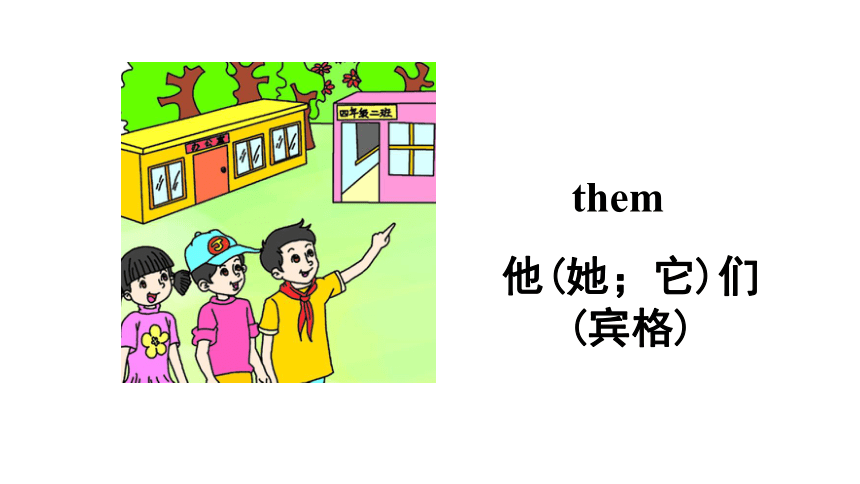
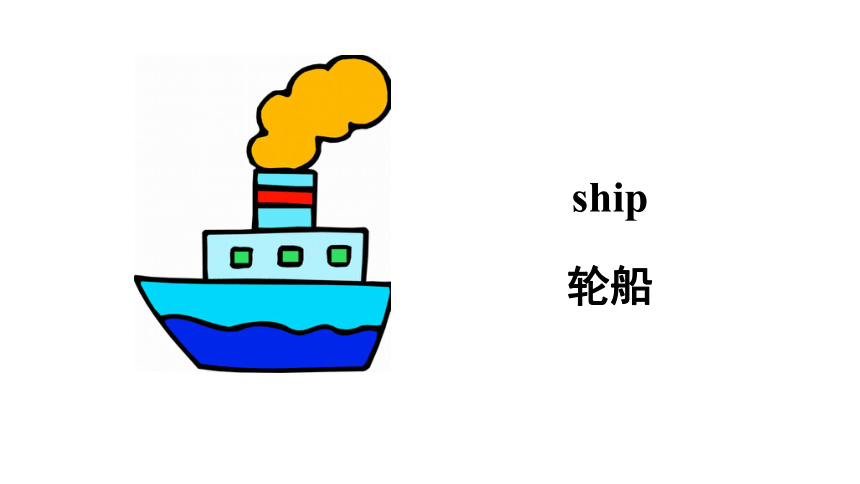

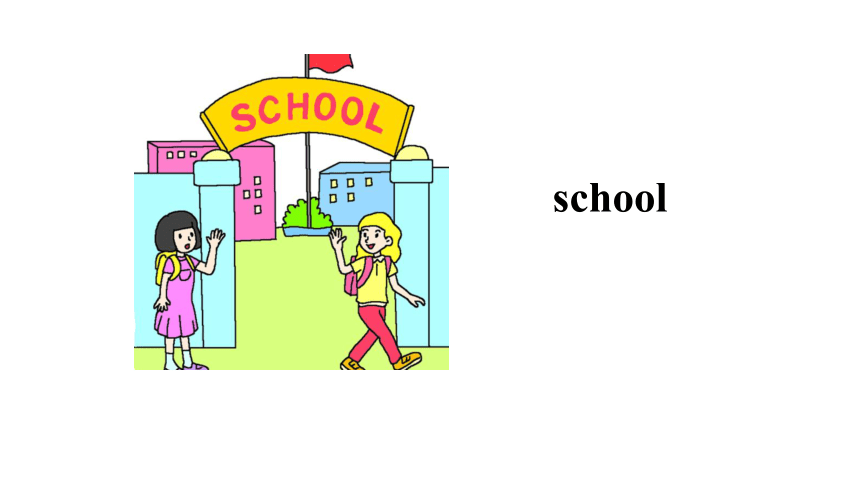

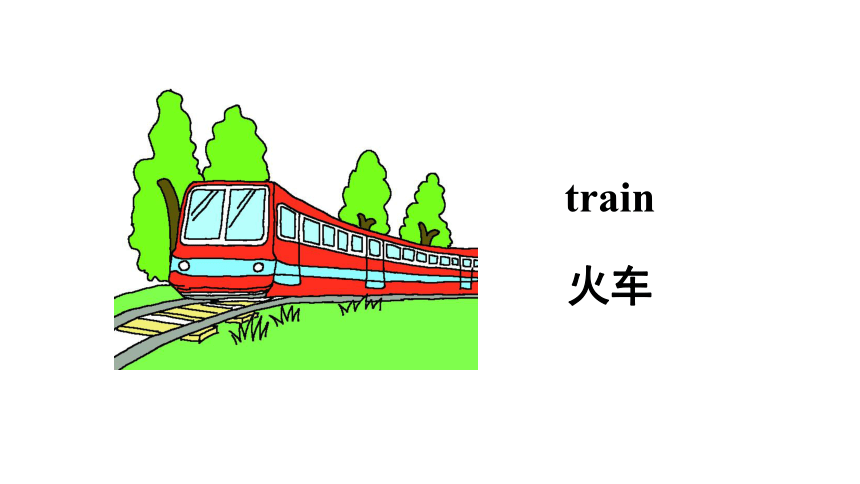
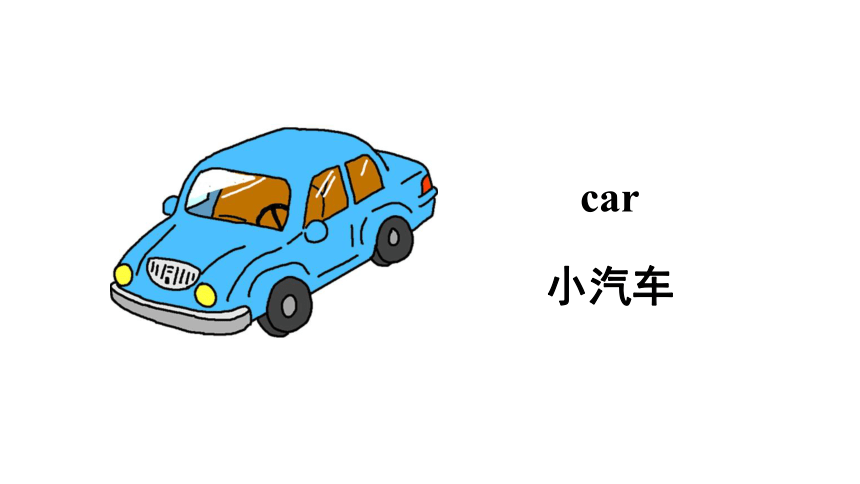

文档简介
Unit 12 I go to school by bus
湘少版·三年级下册
New words
go to
去……
by
乘;通过
bus
公共汽车
them
他(她;它)们(宾格)
ship
轮船
plane
飞机
school
bike
自行车
train
火车
car
小汽车
point to
指向
taxi
出租车
come in
进来
on
在……上面
road
道路
New words
Let’s listen and say
Do you know them?
1
A ship.
A plane.
I go to Shanghai by ship.
Good.
I go to Beijing by plane.
2
3
? ?
I go to school by bike.
I go to school by bus.
4
5
Language points
1. Do you know them? 你认识他们吗?
them是 they 的宾格形式,意思是“他们”,在句中作宾语或表语。
当人称代词在句中作主语时就要用主格;在句中作宾语或表语时就要用宾格。
第一人称
第二人称
第三人称
单数
复数
单数
复数
单 数
复 数
人
称
代
词
主格
宾格
汉语意思
I
we
you
you
she he it
they
me
us
you
you
her him it
them
我
我们
你
你们
她 他 它
他们
人称代词的主、宾格形式如下:
2. I go to Shanghai by ship. 我乘轮船去上海。
(1)go是动词,意思是“去”,后面常跟 to。
表达去某地的句型:go to +地点名词.
当后面接的地点是副词时,要把to去掉。
例句:她去杭州。
She goes to Hangzhou.
(2)by表示某种方式,意思是“乘,坐”。
by + 表示交通工具的名词 乘/坐某种交通工具
其中名词前无任何修饰语,且只能用单数。
类似的词组:by car 乘车 by plane 乘飞机
by ship 乘船 by taxi 乘计程车
拓展:take a/the + 表示交通工具的名词 乘/坐……
例句:我乘出租车到医院。
I take a taxi to the hospital.
注意:by和交通工具之间不能加任何冠词,不能说by a train,要是加冠词,只能把by换成take,即:take a train。
Let’s learn
bus train ship
公共汽车
火车
轮船
car plane bike
小汽车
飞机
自行车
Let’s act
1
2
3
I go to school by bike.
I go to Beijing by plane.
We go to Shanghai by train.
Let’s read
1
2
Dino, point to a ship.
Dino, point to a taxi.
3
4
Come in.
Sorry, we’re playing here.
Please don’t play on the road!
Language points
1. Dino, point to a ship. 迪诺,指一指轮船。
point的意思是“指”。当要表达“指向某人或某物”时,就用“point to + 人/物”,其中 to 表示方向。
例句:指一指门。
Point to the door.
2. Sorry, we’re playing here. 对不起,我正在这儿玩。
(1)sorry的意思是“对不起,难过的”,当影响、打扰
别人、做错了事或别人发生了不愉快的事情后,都
可以说 “Sorry./I’m sorry.” 表示道歉或同情。
例句:对不起,我迟到了。
I’m sorry, I’m late.
(2)此句为现在进行时,现在进行时主要用于表示目前
正在进行的动作,有时也可表示现阶段在进行的动作。
句型结构:主语+am/is/are+动词的现在分词+其他。
现在进行时常用的句型:
①肯定式:主语+be+v-ing+其它。
例句: He is reading book. 他正读书。
②否定式:主语+be+not+v-ing+其它。
例句:He isn’t reading book. 他没有在读书。
① 一般情况下在动词词尾加ing。例如:look → looking
② 以不发音的e结尾的动词,去掉e加ing。
例如:take → taking???
现在分词的构成规则
③ 以一个辅音字母结尾的重读闭音节,双写最后
一个字母,再加-ing。
例如:get → getting?? swim → swimming??
3. Please don’t play on the road! 请不要在马路上玩!
这是一个祈使句,祈使句是表达命令、请求、劝告、警告、禁止等的句子,祈使句最常用于表达命令,因此也常称为命令句。祈使句因对象(即主语)是第二人称,所以通常都省略。祈使句的动词都为一般现在时,句末则使用句号来表示结束。
句型结构:Please + don’t + 动词原形+ 其他.
please的意思是“请”,可以放在句首也可以放在句末,当 please 放在句末时,常用逗号与前面的部分隔开。
例句:请不要在上课时讲话。
Please don’t talk in class.
Let’s learn to learn
Let’s do a mind map.
I go to …
by ship
by bus
by plane
by bike
Changsha
Shanghai
Beijing
Let’s chant
Cold, cold,
It’s a cold day.
Old, old,
We see an old play.
Oo
Let’s have fun
Turn the wheel and talk about the picture.
Let’s know more
What can we do in a bus?
Please take my seat.
You are a very good boy. Thank you.
Hello, please sit here. Let me help you.
You are a good girl. Thank you.
Language points
1. Please take my seat. 请坐我的座位。
seat 是名词,意思是“座位”。
例句:This seat is mine. 这个座位是我的。
拓展:sit是动词,意思是“坐”。
例句:他们坐在沙发上。
They sit on the sofa.
2. Let me help you. 让我帮助你。
(1)这一句是由let引导的祈使句。
句型结构:Let + 某人+ 动词原形+ 其他。
① 表示“间接命令”或“愿望”。这句型里的动词宾语是第三人称名词或代词。
例句:Let her join our group. 让她加入我们组。
let引导的祈使句用法:
② 表示“建议”。这个句型里的 “let”后头紧跟着
一个第一人称的代词宾语。
例句:Let me have a look. 让我看一看。
Let’s do it! 我们来做一做吧!
(2)help是动词,意思是“帮助”。
常用的短语:help sb. (to) do sth. 帮某人做某事;
help oneself 自用(食物等)。
例句:请帮我做这份工作。
Please help me to do this work.
湘少版·三年级下册
New words
go to
去……
by
乘;通过
bus
公共汽车
them
他(她;它)们(宾格)
ship
轮船
plane
飞机
school
bike
自行车
train
火车
car
小汽车
point to
指向
taxi
出租车
come in
进来
on
在……上面
road
道路
New words
Let’s listen and say
Do you know them?
1
A ship.
A plane.
I go to Shanghai by ship.
Good.
I go to Beijing by plane.
2
3
? ?
I go to school by bike.
I go to school by bus.
4
5
Language points
1. Do you know them? 你认识他们吗?
them是 they 的宾格形式,意思是“他们”,在句中作宾语或表语。
当人称代词在句中作主语时就要用主格;在句中作宾语或表语时就要用宾格。
第一人称
第二人称
第三人称
单数
复数
单数
复数
单 数
复 数
人
称
代
词
主格
宾格
汉语意思
I
we
you
you
she he it
they
me
us
you
you
her him it
them
我
我们
你
你们
她 他 它
他们
人称代词的主、宾格形式如下:
2. I go to Shanghai by ship. 我乘轮船去上海。
(1)go是动词,意思是“去”,后面常跟 to。
表达去某地的句型:go to +地点名词.
当后面接的地点是副词时,要把to去掉。
例句:她去杭州。
She goes to Hangzhou.
(2)by表示某种方式,意思是“乘,坐”。
by + 表示交通工具的名词 乘/坐某种交通工具
其中名词前无任何修饰语,且只能用单数。
类似的词组:by car 乘车 by plane 乘飞机
by ship 乘船 by taxi 乘计程车
拓展:take a/the + 表示交通工具的名词 乘/坐……
例句:我乘出租车到医院。
I take a taxi to the hospital.
注意:by和交通工具之间不能加任何冠词,不能说by a train,要是加冠词,只能把by换成take,即:take a train。
Let’s learn
bus train ship
公共汽车
火车
轮船
car plane bike
小汽车
飞机
自行车
Let’s act
1
2
3
I go to school by bike.
I go to Beijing by plane.
We go to Shanghai by train.
Let’s read
1
2
Dino, point to a ship.
Dino, point to a taxi.
3
4
Come in.
Sorry, we’re playing here.
Please don’t play on the road!
Language points
1. Dino, point to a ship. 迪诺,指一指轮船。
point的意思是“指”。当要表达“指向某人或某物”时,就用“point to + 人/物”,其中 to 表示方向。
例句:指一指门。
Point to the door.
2. Sorry, we’re playing here. 对不起,我正在这儿玩。
(1)sorry的意思是“对不起,难过的”,当影响、打扰
别人、做错了事或别人发生了不愉快的事情后,都
可以说 “Sorry./I’m sorry.” 表示道歉或同情。
例句:对不起,我迟到了。
I’m sorry, I’m late.
(2)此句为现在进行时,现在进行时主要用于表示目前
正在进行的动作,有时也可表示现阶段在进行的动作。
句型结构:主语+am/is/are+动词的现在分词+其他。
现在进行时常用的句型:
①肯定式:主语+be+v-ing+其它。
例句: He is reading book. 他正读书。
②否定式:主语+be+not+v-ing+其它。
例句:He isn’t reading book. 他没有在读书。
① 一般情况下在动词词尾加ing。例如:look → looking
② 以不发音的e结尾的动词,去掉e加ing。
例如:take → taking???
现在分词的构成规则
③ 以一个辅音字母结尾的重读闭音节,双写最后
一个字母,再加-ing。
例如:get → getting?? swim → swimming??
3. Please don’t play on the road! 请不要在马路上玩!
这是一个祈使句,祈使句是表达命令、请求、劝告、警告、禁止等的句子,祈使句最常用于表达命令,因此也常称为命令句。祈使句因对象(即主语)是第二人称,所以通常都省略。祈使句的动词都为一般现在时,句末则使用句号来表示结束。
句型结构:Please + don’t + 动词原形+ 其他.
please的意思是“请”,可以放在句首也可以放在句末,当 please 放在句末时,常用逗号与前面的部分隔开。
例句:请不要在上课时讲话。
Please don’t talk in class.
Let’s learn to learn
Let’s do a mind map.
I go to …
by ship
by bus
by plane
by bike
Changsha
Shanghai
Beijing
Let’s chant
Cold, cold,
It’s a cold day.
Old, old,
We see an old play.
Oo
Let’s have fun
Turn the wheel and talk about the picture.
Let’s know more
What can we do in a bus?
Please take my seat.
You are a very good boy. Thank you.
Hello, please sit here. Let me help you.
You are a good girl. Thank you.
Language points
1. Please take my seat. 请坐我的座位。
seat 是名词,意思是“座位”。
例句:This seat is mine. 这个座位是我的。
拓展:sit是动词,意思是“坐”。
例句:他们坐在沙发上。
They sit on the sofa.
2. Let me help you. 让我帮助你。
(1)这一句是由let引导的祈使句。
句型结构:Let + 某人+ 动词原形+ 其他。
① 表示“间接命令”或“愿望”。这句型里的动词宾语是第三人称名词或代词。
例句:Let her join our group. 让她加入我们组。
let引导的祈使句用法:
② 表示“建议”。这个句型里的 “let”后头紧跟着
一个第一人称的代词宾语。
例句:Let me have a look. 让我看一看。
Let’s do it! 我们来做一做吧!
(2)help是动词,意思是“帮助”。
常用的短语:help sb. (to) do sth. 帮某人做某事;
help oneself 自用(食物等)。
例句:请帮我做这份工作。
Please help me to do this work.
同课章节目录
- Unit 1 How are you?
- Unit 2 Are you Lingling?
- Unit 3 What colour is this balloon?
- Unit 4 Look at the T-shirts.
- Unit 5 What time is it?
- Unit 6 How many pens are there?
- Unit 7 Is this an orange?
- Unit 8 I like a sunny day.
- Unit 9 What's the weather like?
- Unit 10 Is he a farmer?
- Unit 11 What's he?
- Unit 12 I go to school by bus.
